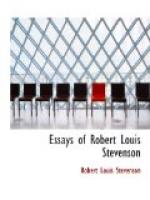[Note 3: Hazlitt, to Lamb, to Wordsworth, to Sir Thomas Browne, to Defoe, to Hawthorne, to Montaigne, to Beaudelaire, and to Obermann. For Hazlitt, see Note 19 of Chapter II above. Charles Lamb (1775-1834), author of the delightful Essays of Elia (1822-24), the tone of which book is often echoed in Stevenson’s essays.... Sir Thomas Browne (1605-1682), regarded by many as the greatest prose writer of the seventeenth century; his best books are Religio Medici (the religion of a physician), 1642, and Urn Burial (1658). The 300th anniversary of his birth was widely celebrated on 19 October 1905.... Daniel Defoe (1661-1731), an enormously prolific writer; his first important novel, Robinson Crusoe (followed by many others) was written when he was 58 years old.... Nathaniel Hawthorne, the greatest literary artist that America has ever produced was born 4 July 1804, and died in 1864. His best novel (the finest in American Literature) was The Scarlet Letter (1850).... Montaigne. Stevenson was heavily indebted to this wonderful genius. See Note 4 of Chapter VI above. ... Charles Baudelaire (1821-1867) wrote the brilliant and decadent Fleurs du Mai (1857-61). He translated Poe into French, and was partly responsible for Poe’s immense vogue in France. Had Baudelaire’s French followers possessed the power of their master, we should be able to forgive them for writing.... Obermann. Obermann is the title of a story by the French writer Etienne Pivert de Senancour (1770-1846). The book, which appeared in 1804, is full of vague melancholy, in the Werther fashion, and is more of a psychological study than a novel. In recent years, Amiel’s Journal and Sienkiewicz’s Without Dogma belong to the same school of literature. Matthew Arnold was fond of quoting from Senancour’s Obermann.]
[Note 4: Ruskin ... Pasticcio ... Bordello ... Morris ... Swinburne ... John Webster ... Congreve. These names exhibit the astonishing variety of Stevenson’s youthful attempts, for they represent nearly every possible style of composition. John Ruskin (1819-1900) exercised a greater influence thirty years ago than he does to-day Stevenson in the words “a passing spell,” seems to apologise for having been influenced by him at all.... Pasticcio, an Italian word, meaning “pie”: Swinburne uses it in the sense of “medley,” which is about the same as its significance here. Sordello: Stevenson naturally accompanies this statement with a parenthetical exclamation. Sordello, published in 1840, is the most obscure of all Browning’s poems, and for many years blinded critics to the poet’s genius. Innumerable are the witticisms aimed at this opaque work. See, for example, W. Sharp’s Life of Browning ... William Morris (1834-96), author of the Earthly Paradise (1868-70): for his position and influence in XIXth century literature see H.A. Beers, History of English Romanticism, Vol. II.... Algernon Charles Swinburne, born 1837, generally regarded (1906) as England’s foremost living poet, is famous chiefly for the melodies of his verse. His influence seems to be steadily declining and he is certainly not so much read as formerly.... For John Webster and Congreve, see Notes 37 and 26 of Chapter IV above.]




